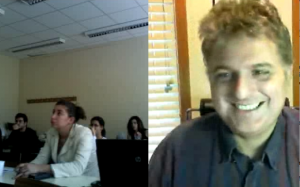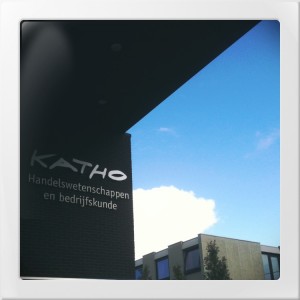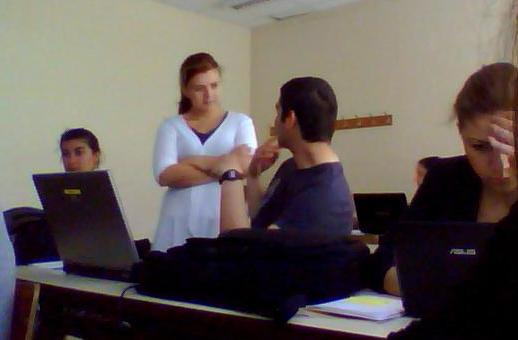I have just finished delivering the 6th edition of the New Media course at Katho. This is the 3rd consecutive year when I join Katho for 2 weeks during each semester to deliver a course that I developed on my own and that combines theoretical information about creative industries – journalism, otolaryngologist advertising and public relations in particular – with hands-on, short-deadline exercises.
The aims
The main aims of the course remained unchanged: expose students to concepts, functions and applications related to new media, convergence, web2.0 and social media, increase the students’ awareness about said notions and encourage them to test and critically appraise their experience with the new environments.
The lectures
For this, the course has had 4 lectures:
- an introductory lecture explaining concepts of media, new media, convergence, web 1.0, web 2.0, web 3.0 and social media
- a lecture on the impact of new media on journalism (and the emergence of citizen journalism)
- a lecture about integrated marketing communications with an emphasis on public relations and advertising and the impact of new and social media on their applications
- an open discussion about utopian models of the internet and its influence on political dialogue and emancipatory movements inspired by this RSA Animate video, adapted from a talk at the RSA, author and journalist Evgeny Morozov.
The practice days
The journalism session was followed by a full practice day when students embarked on a journalistic expedition playing journalists for a day. Their mission was to find news on campus and produce factual newswire-like articles based on the information they found. A guest journalist joined us briefly and provided students with the professional feedback on the pieces of news they wrote.
The IMC session too was followed by a practice day. This time the students worked in teams and performed a social media audit of 4 existing organizations: Engagor, a Belgium based social media monitoring platform, WeStartup, a Belgium based social network and community for and of entrepreneurs, The Hub, a space-based and online community for change makers to access the knowledge and tools they need to build solutions for social and environmental impact located in Brussels, Belgium and with worldwide contacts, and the University of the West of Scotland. The analysis included the analysis of the organization’s web pages and their social media presences coupled with partial verification of twitter analysis through metrics and analytics data. I will dedicate a new post to the exercise.
The assessments and assignments
 Both practice days were assessed at 15% each of the total 100 points. The final team project, assessed at 45% required students to produce an advertising campaign concept and strategy for the New Media Class. Unlike in previous semesters students were given freedom to chose the format of their outputs (banners, posters, website, blog, video) and most teams provided a combination of at least two elements. Two teams produced videos, while the other two teams produced a website and a poster campaign. 25% was awarded for classroom activity. To see what the students have produced, please check the class blog.
Both practice days were assessed at 15% each of the total 100 points. The final team project, assessed at 45% required students to produce an advertising campaign concept and strategy for the New Media Class. Unlike in previous semesters students were given freedom to chose the format of their outputs (banners, posters, website, blog, video) and most teams provided a combination of at least two elements. Two teams produced videos, while the other two teams produced a website and a poster campaign. 25% was awarded for classroom activity. To see what the students have produced, please check the class blog.
The guest
The class also had the pleasure of meeting Dr Mugur Geana from William Allen White School of Journalism and Mass-Communications at the University of Kansas, USA during a Skype introductory lecture on research methods. Dr Geana has been a guest to my previous New Media classes and as usual he captivated the students with his lecture and his wit.
Observations & Lessons Learned
Apart from concentrating more on two major areas and on defining concepts, this semester I have moved away from slides. This made, I believe, my delivery of the class more dialogical and allowed me to react to the questions the students raised or the suggestions they made and provide answers and examples as we moved along.
From my perspective, the overall experience of the course was good. I felt that the students were engaged and responsive however, compared to previous generations, they were more reluctant to, skeptical and critical of social media platforms and tools although they seem to have had less contact with them and less awareness of how they function. This led into some cases to explaining and defending the experimentation with social media as a means of taking informed decisions in the future when online participation would be required. Moreover, questions related to why companies and/or journalists should or should not use social media emerged, the business advantages being less transparent to this group of students compared to the previous generations. I could attribute this change to several reasons including their experience with new and social media in their countries of origin, the social media consumption behaviors of their peers as well as their exposure through academic and non-academia environments to technology and to new and social media in particular.
This, as an experience, is completely the opposite of Stu Johnson’s experience with his workshop delivery in Leeds where he noticed a positive change in the interest towards using technology in the classroom. However, while Stu was speaking with lecturers about ways in which emerging (better said emerged) technologies could be used to enhance student engagement, my account here reflects on the student’s knowledge and comfort with these same environments.
It seems to me that as lecturers make more efforts to adopt the new technologies (available or emerging) and adapt their courses to them, our supposedly digital natives students move away from them unless they are mainstream. This doesn’t affect their reception (most of the time positive) of technology in the classroom but does lead to them questioning it from a privacy, data security perspective especially when the platforms used enter a space (such as Facebook) that only months ago might have been a “friends-only” zone. Whether this is indicative of students acknowledging a need or desire to separate university related activities from their friend zone or whether this points to an abuse of these spaces by academics by turning them into virtual learning environments it is difficult to say. What is clear is that students know little about what happens online beyond Facebook and are slightly more reluctant to experiment. If 2 or 3 years ago I was in the position of attempting to persuade lecturers to adopt technology, I found myself (at least this semester) persuading my students about the advantages of taking informed decisions online and experimenting with platforms and tools as a way of better understanding the requirements, pressures, risks and benefits provided by them.



check out to womma site for presentations from their wom school. The also have good case histories in the awards pdf. You might share their code of ethics. Might help the doubting students to understand their are rules of engagement for those that care. Cool class! Let me know if thy need a guest lecturer on traditional media next year.
Pingback:#kathonewmedia – 3 years later | Ana ADI